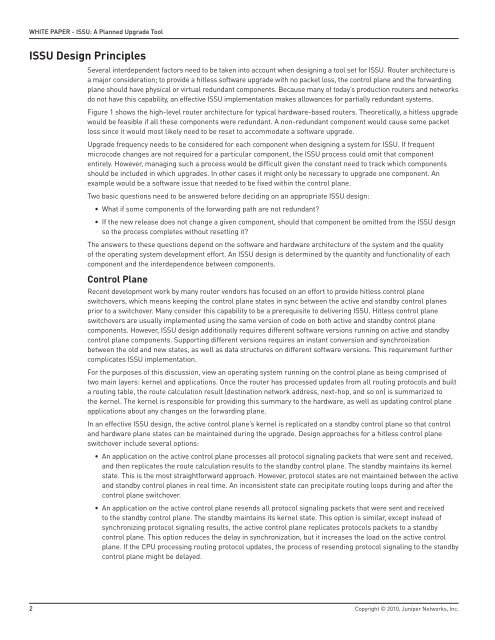ISSU: A Planned Upgrade Tool - Juniper Networks
ISSU: A Planned Upgrade Tool - Juniper Networks
ISSU: A Planned Upgrade Tool - Juniper Networks
You also want an ePaper? Increase the reach of your titles
YUMPU automatically turns print PDFs into web optimized ePapers that Google loves.
WHITE PAPER - <strong>ISSU</strong>: A <strong>Planned</strong> <strong>Upgrade</strong> <strong>Tool</strong><br />
<strong>ISSU</strong> Design Principles<br />
Several interdependent factors need to be taken into account when designing a tool set for <strong>ISSU</strong>. Router architecture is<br />
a major consideration; to provide a hitless software upgrade with no packet loss, the control plane and the forwarding<br />
plane should have physical or virtual redundant components. Because many of today’s production routers and networks<br />
do not have this capability, an effective <strong>ISSU</strong> implementation makes allowances for partially redundant systems.<br />
Figure 1 shows the high-level router architecture for typical hardware-based routers. Theoretically, a hitless upgrade<br />
would be feasible if all these components were redundant. A non-redundant component would cause some packet<br />
loss since it would most likely need to be reset to accommodate a software upgrade.<br />
<strong>Upgrade</strong> frequency needs to be considered for each component when designing a system for <strong>ISSU</strong>. If frequent<br />
microcode changes are not required for a particular component, the <strong>ISSU</strong> process could omit that component<br />
entirely. However, managing such a process would be difficult given the constant need to track which components<br />
should be included in which upgrades. In other cases it might only be necessary to upgrade one component. An<br />
example would be a software issue that needed to be fixed within the control plane.<br />
Two basic questions need to be answered before deciding on an appropriate <strong>ISSU</strong> design:<br />
• What if some components of the forwarding path are not redundant?<br />
• If the new release does not change a given component, should that component be omitted from the <strong>ISSU</strong> design<br />
so the process completes without resetting it?<br />
The answers to these questions depend on the software and hardware architecture of the system and the quality<br />
of the operating system development effort. An <strong>ISSU</strong> design is determined by the quantity and functionality of each<br />
component and the interdependence between components.<br />
Control Plane<br />
Recent development work by many router vendors has focused on an effort to provide hitless control plane<br />
switchovers, which means keeping the control plane states in sync between the active and standby control planes<br />
prior to a switchover. Many consider this capability to be a prerequisite to delivering <strong>ISSU</strong>. Hitless control plane<br />
switchovers are usually implemented using the same version of code on both active and standby control plane<br />
components. However, <strong>ISSU</strong> design additionally requires different software versions running on active and standby<br />
control plane components. Supporting different versions requires an instant conversion and synchronization<br />
between the old and new states, as well as data structures on different software versions. This requirement further<br />
complicates <strong>ISSU</strong> implementation.<br />
For the purposes of this discussion, view an operating system running on the control plane as being comprised of<br />
two main layers: kernel and applications. Once the router has processed updates from all routing protocols and built<br />
a routing table, the route calculation result (destination network address, next-hop, and so on) is summarized to<br />
the kernel. The kernel is responsible for providing this summary to the hardware, as well as updating control plane<br />
applications about any changes on the forwarding plane.<br />
In an effective <strong>ISSU</strong> design, the active control plane’s kernel is replicated on a standby control plane so that control<br />
and hardware plane states can be maintained during the upgrade. Design approaches for a hitless control plane<br />
switchover include several options:<br />
• An application on the active control plane processes all protocol signaling packets that were sent and received,<br />
and then replicates the route calculation results to the standby control plane. The standby maintains its kernel<br />
state. This is the most straightforward approach. However, protocol states are not maintained between the active<br />
and standby control planes in real time. An inconsistent state can precipitate routing loops during and after the<br />
control plane switchover.<br />
• An application on the active control plane resends all protocol signaling packets that were sent and received<br />
to the standby control plane. The standby maintains its kernel state. This option is similar, except instead of<br />
synchronizing protocol signaling results, the active control plane replicates protocols packets to a standby<br />
control plane. This option reduces the delay in synchronization, but it increases the load on the active control<br />
plane. If the CPU processing routing protocol updates, the process of resending protocol signaling to the standby<br />
control plane might be delayed.<br />
2 Copyright © 2010, <strong>Juniper</strong> <strong>Networks</strong>, Inc.
















